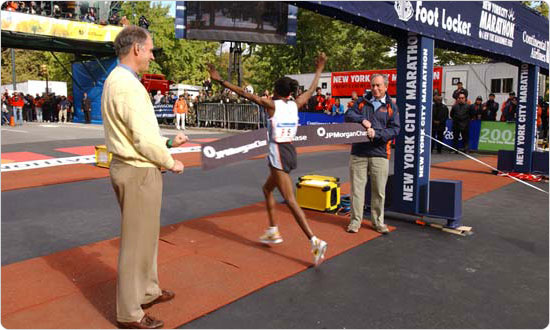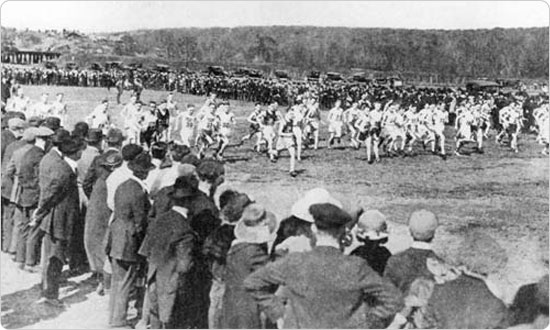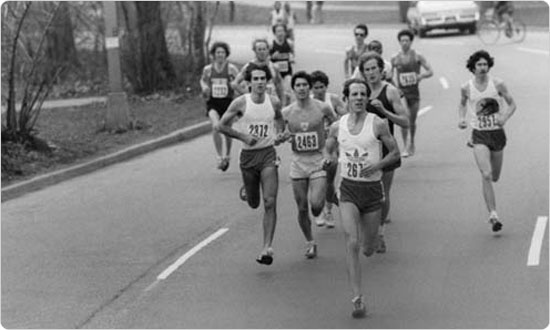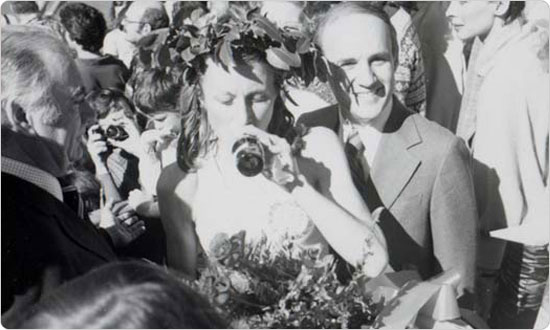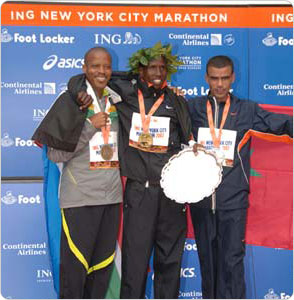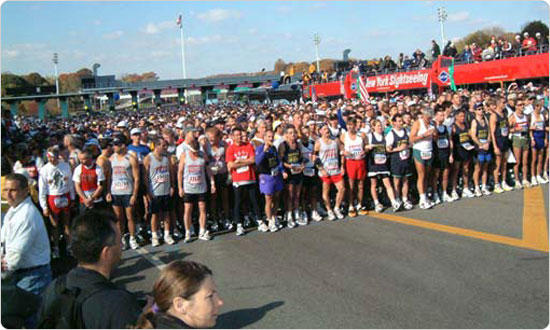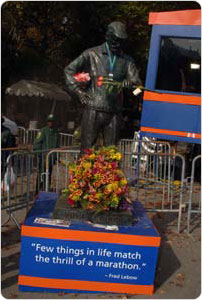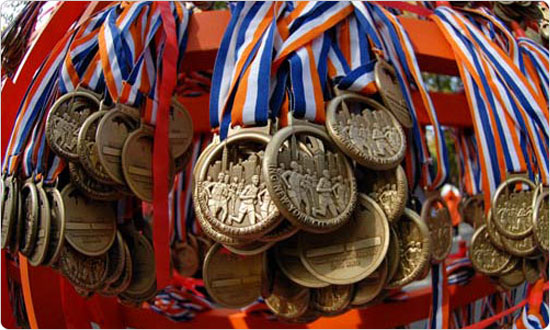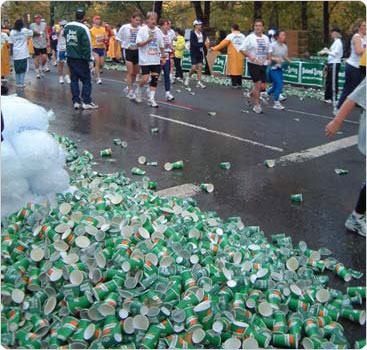The History of the New York City Marathon
One of New York City's most famous events is the New York City Marathon, which runs each year in early November. Since its modest beginning in Central Park when 127 runners participated in front of a meager cheering section, the race has grown to include over 39,000 participants who traverse the five boroughs in front of, organizers say, two million spectators and a worldwide television audience of 315 million.
The modern marathon dates to the first (modern) Olympics in Athens in 1896. The course length is derived from the apocryphal story of the army messenger Pheidippides, who, as the story goes, in 490 B.C. raced 26.2 miles back to Athens from Marathon to give word of the Greek military win over Persia. In fact, the 26–mile, 385–yard distance was not agreed upon until 1921—the first races were about 40 kilometers (25 miles), which is roughly the distance between Athens and Marathon.
Although the New York City Marathon is now the largest such race, it is not the oldest. The Boston Marathon, which began in 1897 after Athens, is the oldest continuous marathon in the world. The New York City Marathon also has several precursors in the area. The first marathon in the metropolitan New York area occurred in Yonkers across the city line in Westchester County in November 1907. The eventual 1908 Olympic gold medalist John J. "Johnny" Hayes won the 25–mile race. The Irish–born Johnny Hayes was an employee of Bloomingdale's, and trained for his Olympic run on the roof of the store at night on a cinder–path track installed by the company. In the 1908 Olympics, Hayes set a World Record by beating the Italian Dorando Pietri (known simply as "Dorando") after Dorando collapsed upon entering the Olympic Stadium; Hayes was the last gold medalist in the marathon until 1972, when Frank Shorter won the event at Munich, Germany.
Marathons Hit City Streets
The exciting 1908 Olympic race set off a flurry of marathon mania around the United States, and there were many marathon races in 1908 and 1909 around New York. In 1908, the New York Evening Journal sponsored what appears to have been the first marathon run on New York City streets. The race was run on December 26, 1908, and began in Rye in Westchester County, following the Boston Post Road to Pelham Bay Park, crossing over the Hutchinson River and continuing down Fordham Road to Jerome Avenue, over the Harlem River via the Macomb's Dam Bridge and down Seventh Avenue (now Adam Clayton Powell Boulevard) to 110th Street, finally winding around Central Park via Central Park West down to 59th Street at Columbus Circle. Marathons in 1908 and 1909 were also run in the second incarnation of Madison Square Garden off of Madison Square Park at 26th Street. The events were considered rematches of the Olympic races and included Dorando and the Onondaga Native American Olympic runner Tom Longboat. In April 1909 Dorando, Hayes, Longboat, and Evening Journal Marathon winner Matthew Maloney competed at the Polo Grounds in Manhattan in a "Marathon Derby." The crowd at the Polo Grounds was estimated at 25,000 and did not include large numbers of people assembled in Times Square to hear news about the race; bookmakers even took bets right in the Polo Grounds; the runner Henri St. Yves, a French waiter, won that battle.
Events like "modified marathons" expanded the pool of runners in subsequent years. A large pool of athletes participated in a 12–mile modified marathon from Fordham in the Bronx to City Hall in May 1911. In May 1912, 1,300 runners competed in a repeat of the event, which was sponsored by the Evening Mail. Other modified marathons included a 15–mile race in Coney Island, Brooklyn in February 1922 and a 16–mile race from Worth Street to 225th Street and Broadway in Manhattan (before Marble Hill was separated by the reconstruction of the Harlem River Ship Canal) in October 1922. And in 1926, Mayor James J. Walker greeted runners at City Hall at the end of the modified marathon. In 1928, a modified marathon sponsored by Il Progresso, the Italian–language daily newspaper, ran from Elm Street in Manhattan to Luna Park in Coney Island, Brooklyn; the event was marred by injuries when participants collided with automobiles in traffic (street closures were less common than now).
The Port Chester Marathon, which began in Manhattan and ended in Westchester County, was a major stop on the running circuit from 1925 to 1941. Held in October, the course ran from Columbus Circle over to 59th Street and Fifth Avenue, north on Fifth Avenue to 138th Street where participants crossed the Harlem River over the Madison Avenue Bridge, continued up the Grand Concourse to Fordham Road, and continued east on the Pelham Parkway to the Boston Post Road into Westchester County. In 1925, Albert Michelsen set a world record that held for ten years running from New York to Port Chester in just under two and–a–half hours. Subsequent races began at Morningside Avenue and 124th Street and ran through Woodlawn in The Bronx. In 1933, one of the runners was hit by an automobile (but still finished).
Yet another marathon known as the Long Beach Marathon ran from the New York Athletic Club on Central Park South, over the Queensboro Bridge, through Queens to Jamaica, where runners followed Merrick Boulevard out to Long Beach in Nassau County. In 1927 the Hopi Native American runner Quanowahu won the race, beating out Albert Michelsen and a Long Island Rail Road train that crossed in front of Michelsen at Long Beach that cost Michelsen to be delayed 14 seconds (though Michelsen, it was noted in reports, cut corners during the race instead of running down the center of the roadway). Another marathon was held on September 12, 1948 to commemorate the 50th anniversary of the consolidation of New York City. Organized by the Queens Committee for the Commemoration of the Golden Anniversary of the City of New York, in connection with the Jefferson Democratic Club, the course ran from Idlewild Airport in Queens (now John F. Kennedy International Airport) to the World's Fair grounds at Flushing Meadows. 1948 Boston Marathon winner Gerard Cote competed in the race.
The New York City Marathon Is Born
The precursor of the New York City Marathon that we know today was the Cherry Tree Marathon, which ran through Bronx streets in February from 1959 to 1970 on Washington's Birthday (thus the name). The Cherry Tree Marathon was organized by the Road Runners Club–New York Association, now known as New York Road Runners (NYRR), which was established in June 1958. The original 40–member group has blossomed into 45,000 members and expanded to include other running–related activities and programs. The group's first meeting was held at Macombs Dam Park in the Bronx where it elected 1952 Olympian Ted Corbitt as its first president. The Cherry Tree Marathons started and finished in Macombs Dam Park near Yankee Stadium, running north up Sedgwick Avenue along the Harlem River and looping back again three times. The February race days were sometimes problematic; in 1963, runners faced near–blizzard conditions. During the 1960s, the Road Runners Club also ran a 35–mile "supermarathon" in Alley Pond Park in Queens.
There were about 250 members in 1970 when NYRR produced the inaugural New York City Marathon in Central Park. The first New York City Marathon was staged entirely in Central Park and had 127 participants, only one of them female. The course was four loops around the park, and the first ten finishers received wristwatches. (Today, the male and female winners receive $130,000.) Race organizer Fred Lebow (1932–1994) used his own money to purchase the prizes. The winner of the first race, Gary Muhrcke, a New York City fireman, finished with a time of 2:31:38, well off the then–world record of 2:08:34 (although world records later fell in the New York Marathon; in 1981, running great Alberto Salazar set a new world record of 2:08:13).
The New York City Marathon grew steadily in subsequent years, though not without its mishaps. In 1971, marathon organizers added a finish–line banner but printed the lettering on the wrong side, and in 1972, six women raced under protest against the Amateur Athletic Union rule that had women start ten minutes after the men. Still, the race's popularity increased, and in 1973 new sponsors Olympic Airways contributed an all–expenses paid trip to Athens for the race winner. Today, the ING New York City Marathon has dozens of sponsors and partners (ING has been the title sponsor of the New York City Marathon since 2003).
The Route
In honor of the Bicentennial, in 1976 the Marathon was re–routed to travel through the streets of all five boroughs, highlighting New York's diverse population, and in 1977 the route expanded into more neighborhoods. Race organizers intended it to be a model for other marathon courses, and the route in fact highlights some of the city's most important landmarks, including many parks. From Fort Wadsworth in Staten Island to Central Park, the race route makes for an excellent tour of the city. In Brooklyn, runners pass by or through Leif Ericson Park in Bay Ridge, J.J. Byrne Park in Park Slope, Fowler Square in Fort Greene and McCarren Park in Greenpoint. In Queens, runners make a turn at Old Hickory Park just off the Pulaski Bridge in Long Island City and hang a right at Gordon Triangle before getting on the Queensboro Bridge. The race swings by Graham Square in the Bronx before heading back into Manhattan where runners skirt around Marcus Garvey Park and eventually into Central Park, where it all began in 1970.
Notable Runners
For 2008, the elite competition included 21 Olympians and six Olympic medalists. Notable runners in the past include Alberto Salazar, who besides breaking the world record in 1981 ran the fastest debut marathon in history in 1980 and won the race. Bill Rogers won the marathon four consecutive times from 1976 to 1979. Norwegian Grete Waitz was a nine–time Marathon champ and was honored in 2008 on the 30th anniversary of her first New York City Marathon win with her image on the finisher medal. Waitz set a world record at the New York City Marathon on October 28, 1978 with a time of 2:32:30, just off the pace of the first (male) marathon winner just eight years earlier. (NYRR's annual half–marathon is known as "Grete's Great Gallop.") In 1992, Waitz ran with NYRR President Fred Lebow when Lebow was suffering from brain cancer; he finished the race in just over five and–a–half hours. Each year a statue of Lebow created by Jesus Ygnacio Dominguez depicting Lebow checking his watch in his trademark running suit and hat is placed near the Marathon's finish line near the West Drive at 67th Street in Central Park to greet runners.
Growing Popularity and Staff
In 1981, ABC Sports began televising the race, the year Salazar set the world record, and in 1982 the marathon became the highest–rated sports show of the day for the network. A waiting list was instituted in 1982 as well, and today over 105,000 entrants compete in a lottery system for roughly 39,000 slots (a portion of the entrants guarantee their participation by running in support of affiliated charity). Racers come from all 50 states and more than 100 countries, and it is a custom of sorts for some runners, though not the lead runners, to dress in elaborate costumes.
The statistics for the New York City Marathon are impressive in themselves. NYRR has over 100 staff working year–round on the marathon. More than 6,000 volunteers participate on race day. 2,500 media credentials are issued. And the Barilla Marathon Eve Dinner feeds 15,000 marathoners and their guests 6,840 pounds of pasta, 1,800 pounds of salad, 15,000 apples, and 18,000 cans of light beer (!). At the starting line, NYRR sets up 1,450 portable toilets, hands out 30,000 PowerBars and 90,000 bottles of water, and serves 40,000 cups of coffee. During the race, volunteers will hand out 62,370 gallons of water and 32,040 gallons of Gatorade in 2,250,000 paper cups while 80 photographers snap 450,000 photos of racers. And the 41 medical aid stations along the way are outfitted with over five tons of ice, 13,475 adhesive bandages, and 390 tubs of Vaseline.
Whether you're a participant or spectator, the New York City Marathon is a major event, and Parks is pleased to be a part of it.
